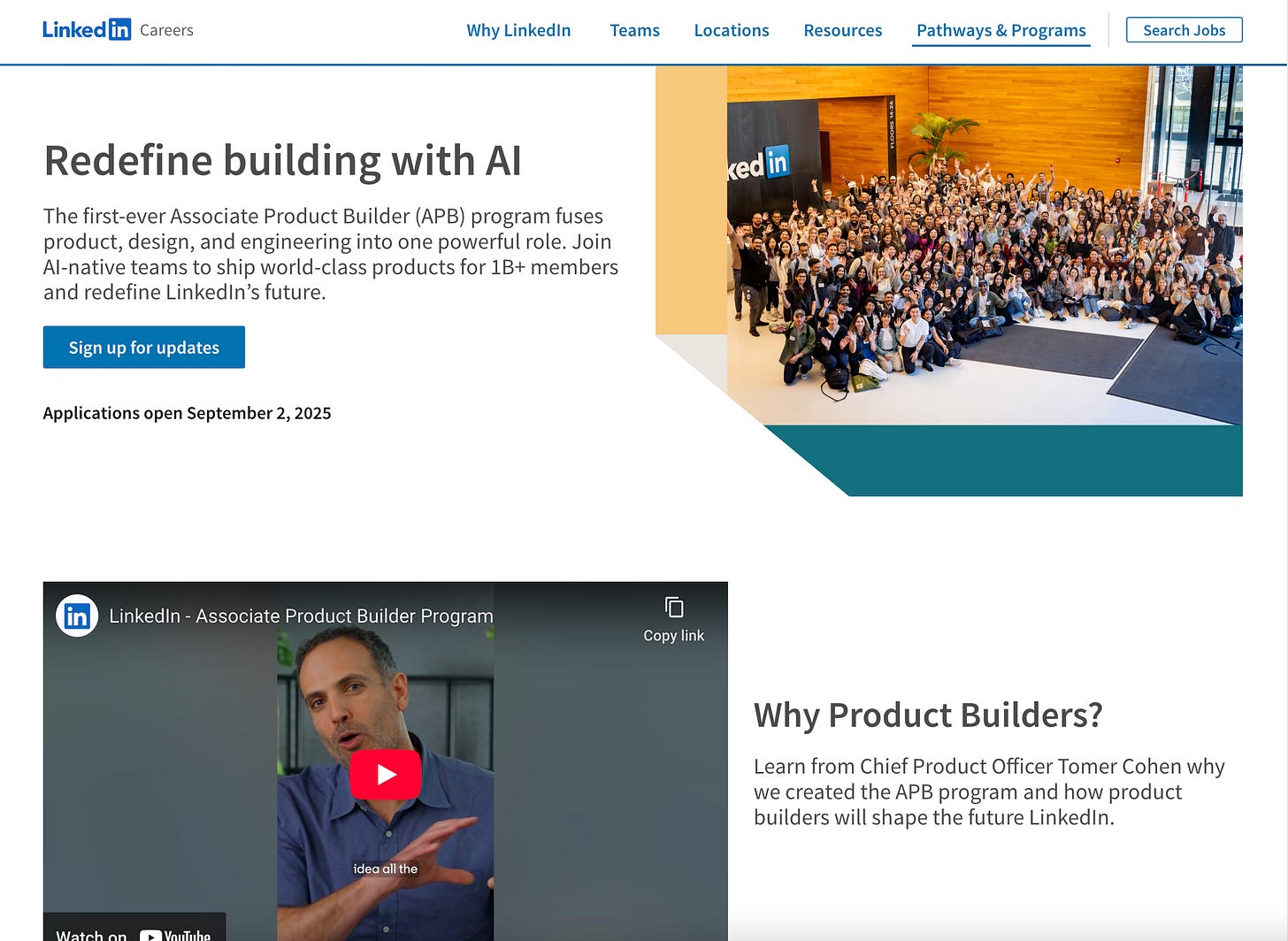LinkedIn's APB (Associate Product Builder) 2025 program opens 9/2. Here are 3 ways to start preparing today.
💎 Welcome to work smarter, my newsletter on building your career and designing your life.
If you’re not a subscriber yet, here’s what you missed:
5 AI prompts to level-up product strategy, executive presence, and execution speed
The stories that got me hired as a PM involved 0 technical skills
how to prepare for AI product manager interviews, part 1: product sense
Update on 9/2: the Associate Product Builder program is now open, and these are the application questions:
What was the problem or opportunity you were addressing? (DO NOT exceed 250 characters)
What did you build? (DO NOT exceed 150 characters)
What was your role in building it (design, code, prototype, etc.)? (DO NOT exceed 150 characters)
Tell us about the impact of the product (e.g., metrics or feedback). (DO NOT exceed 350 characters)
What was your tech stack? What AI did you use in the product? (DO NOT exceed 250 characters)
What was your key customer learning or product insight related to this product? (DO NOT exceed 150 characters)
You’ll see that the questions are similar to what I predicted in the earlier version of this blog post, and in other blog posts dedicated to vibe coding, personal projects, and AI prototyping!
LinkedIn replaced their Associate Product Management (APM) program with a Associate Product Builder program that opens on 9/2.
Here’s how you start preparing now, so that you can submit your application when it opens on 9/2.
In this blog post:
Step 1: How to brainstorm project ideas that solve a real problem and showcase your product sense
Key program info
What is the LinkedIn Associate Product Builder program?
The first-ever Associate Product Builder (APB) program fuses product, design, and engineering into one powerful role. Join AI-native teams to ship world-class products for 1B+ members and redefine LinkedIn’s future.
How to apply
Applications open September 2, 2025, and close September 7, 2025 at 11:59pm PST. You’ll apply right here.
The application is builder-first, just like the program. You’ll share:
A 60-second demo of a product you built that people use or have used (website, repo, portfolio, etc).
Answer a few questions about what you built and how you built it using AI tools
No resume. We want your work, not your job history.
What kinds of problems will I work on?
As an APB, you’ll build AI-powered products that help professionals connect to opportunity. From improving job matches to uncovering untapped talent, you’ll tackle real-world problems that impact over a billion people using LinkedIn’s unique data and AI to move careers and the global economy forward.
Is this role more technical or more product-focused?
It’s both. As an APB, you’ll develop a full-stack product building mindset. You’ll think across product, design, engineering, and business. You’ll prototype, build, and ship with support from mentors in each discipline, learning to balance technical and strategic skills.
How technical do I need to be?
You don’t need to be an engineering expert, but you should be comfortable working with code, prototyping tools, and AI-assisted development workflows. The goal is to accelerate your learning and build features independently with support.
What support will I get if I’ve never worked in a formal product role?
You don’t need formal product experience. The APB Program is built to teach you from the ground up. You’ll get a structured curriculum, hands-on mentorship across product, design, engineering, and business, and a tight-knit peer community to learn and grow with.
What happens after the program ends?
The APB Program is designed to set you up for long-term success at LinkedIn and beyond. Those who demonstrate strong performance and align with our values are well-positioned to continue leading high-impact work at LinkedIn as Full Stack Builders, either with their current team or a new one.
Can I apply if I’ve already graduated or I’m already working full time?
Yes! The APB program is open to candidates who are ready to make a career pivot or take the next step in their product journey, regardless of whether you’re currently in school or employed.
Do I need a degree or formal training to apply?
Yes, you’ll need to have completed a bachelor’s degree in a technical or product-related discipline by December 2025 in order to be eligible for this cohort.
Can I still apply to the APM program?
No. We are no longer accepting applications for APM. If you're interested in early-career product roles at LinkedIn, APB is the path forward.
How to start preparing today
The application requires you to demo a “product YOU BUILT that people have used (website, repo, portfolio, etc).”
If you haven’t built something before, the simplest way is to use vibe coding tools, also called AI prototyping tools.
Vibe coding is like telling ChatGPT to write code. You describe what you want using plain English, and keep chatting with the tool to refine the website. All without writing a single line of code!)
Step 1: How to brainstorm project ideas that solve a real problem and showcase your product sense
The best projects solve a real problem you’re motivated to solve. To identify a problem worth solving, ask yourself:
Moments of friction
When do you find yourself saying "there has to be a better way to do this"?
What's the most annoying task you do multiple times per week?
What process feels like it has too many unnecessary steps?
What app do you use that makes you think "I wish this had..."?
What's something you procrastinate on because the existing tools are too clunky?
Where do you find yourself regularly using workarounds or hacks?
Workflow gaps
What information do you wish was automatically connected but isn't?
What do you find yourself copying/pasting between different apps?
What reminder or notification do you wish existed but doesn't?
Micro-interactions & delight
What's a boring task that could be surprisingly fun with the right interface?
How could you make something tedious feel like a game?
What's an everyday interaction that could feel more magical?
These questions inspired the personal project that I talked about in my Google APM, Meta RPM, and Microsoft PM interviews.
More project ideas:
Step 2: Use a vibe coding tool and start with a simple project
Easiest tools to get started with:
Examples of easy projects:
“Make a 2-player tic-tac-toe game.” ← just paste this into the text box of any of the tools I mention above. Then, keep chatting with the tool until you get it to look exactly the way you want it to.
Step 1: How to come up with project ideas that solve a real problem and showcase your product sense
The best projects solve a real problem you’re motivated to solve. To identify a problem worth solving, ask yourself:
Moments of friction
When do you find yourself saying "there has to be a better way to do this"?
What's the most annoying task you do multiple times per week?
What process feels like it has too many unnecessary steps?
What app do you use that makes you think "I wish this had..."?
What's something you procrastinate on because the existing tools are too clunky?
Where do you find yourself regularly using workarounds or hacks?
Workflow gaps
What information do you wish was automatically connected but isn't?
What do you find yourself copying/pasting between different apps?
What reminder or notification do you wish existed but doesn't?
Micro-interactions & delight
What's a boring task that could be surprisingly fun with the right interface?
How could you make something tedious feel like a game?
What's an everyday interaction that could feel more magical?
Step 2: Pick a no-code prototyping tool
Beginner-friendly tools include:
v0 (Get started for free: v0.dev)
Emergent (Get started for free: emergent.sh)
Lovable (Get started for free: lovable.dev)
Bolt (Get started for free: bolt.new)
HeyBoss (Get started for free: heyboss.ai)
Step 3: Drop your idea in the prototyping tool
Example, paste this:
Build a drag-and-drop flower arrangement app. On the left, show me options for vases, flowers, and leaves. On the right, build a canvas where I can add elements and resize, rotate, crop, and arrange them in layers.
You can also upload screenshots of products you like as inspiration.
Step 4: Continue refining your project by describing the changes you want to see
And if the project has errors, screenshot them and ask the tool to help you fix it.
Step 7: How to talk about your project during your interview
Interviewers will assess your product sense. Similar to the framework you use to solve a product sense interview question, be prepared to talk about:
What problems/pain points are you solving? How did you prioritize which problem to solve?
What solutions did you consider? How did you pick the solution?
Are there existing solutions for this problem? How is your project different from existing solutions?
How did you get people to use the product? What was their feedback? How did prioritize the feedback you were getting? How did you adapt to their feedback?
What were some challenges you encountered while building this? How did you overcome those challenges?
If you had more time, what additional features would you add?
How do you define success for your product?
Additional recruiting resources:
Google APM, Meta RPM, and more: product management internship & full-time application dates
5 AI prompts to level-up product strategy, executive presence, and execution speed
The stories that got me hired as a PM involved 0 technical skills
how to prepare for AI product manager interviews, part 1: product sense



